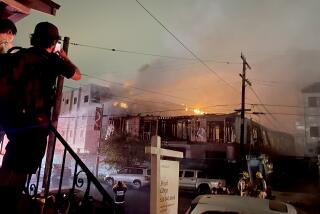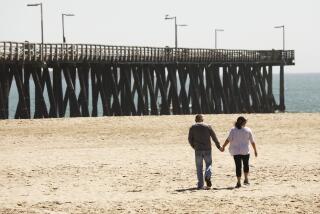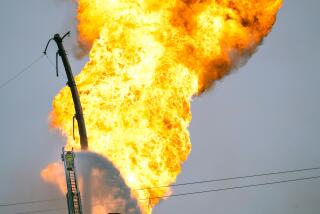San Bruno explosion death toll climbs to seven; six are missing
Reporting from San Bruno and Los Angeles — The death toll mounted to seven Saturday and the search continued for six people still missing three days after a massive gas line explosion tore through a San Bruno neighborhood.
The cause of the disaster remained an open question, with gas company officials saying that the blown pipeline had been inspected just last year.
“We did the whole thing,” said Chris Johns, president of Pacific Gas & Electric, which owns the high-pressure natural gas pipeline that ruptured Thursday. The blast injured dozens and destroyed 37 homes. Hundreds remain displaced.
Utility officials, city leaders and politicians who toured the devastated neighborhood Saturday said a premium is being placed on ensuring the integrity of the gas line and eliminating fear that Thursday’s thunderous explosion could be repeated.
PG&E said it is reinspecting all three natural gas transmission lines serving the San Francisco Peninsula.
On Saturday, hundreds of San Bruno residents — some with gauze bandages wrapping their feet and arms — jammed a town hall meeting, expressing frustration and anger at being prevented from returning to their homes. Some were still wearing the smoky clothes they threw on as they scrambled from their burning homes Thursday evening.
But residents also gave a standing ovation to the city’s fire and police chiefs and an even warmer reception to news that many residents of the 271 evacuated houses would be allowed to return to their neighborhood Sunday. Residents who live near the blast zone, including those in the 37 destroyed homes, will not immediately be permitted to return.
“In a split second, a flash, our lives changed forever,” Mayor Jim Ruane told residents who packed the pews at St. Robert’s Catholic Church.
“This has been a tragedy of immense proportion.”
San Bruno Police Chief Neil Telford confirmed late Saturday that seven were dead and six were missing. Search-and-rescue crews continued to make their way through the disaster area with cadaver dogs.
Additional reports of missing people were filed Saturday, police said. Police officials said they do not know people are missing until relatives contact authorities to say they can’t locate family members.
The San Mateo County coroner’s office questioned the police department’s body count, saying it has only four bodies. Michelle Rippy, senior deputy coroner, said, “We have four confirmed dead.”
Although residents reported smelling gas in the days before the explosion, Johns said the utility had combed through two-thirds of the consumer calls received the week before the blast and found no record of any such complaints. Nor, he said, was there a record of crews responding to the area.
The burst pipeline, which had been installed in 1956, was not uncommonly old, experts said.
“Just like with an old airplane, the key is maintenance,” said Christopher Hart, vice chairman of the National Transportation Safety Board.
Although the safety board’s final report may take a year or more to complete, Hart said, any findings that merit “urgent attention” will be acted on.
Sen. Barbara Boxer (D-Calif.) said officials would push for “robust inspections” of natural gas lines that pass through residential neighborhoods.
“We cannot wait for the answers to this. Inspections are the way to go,” she said. “We have to be very clear that we’re trying to prevent this from ever happening again.”
As officials worked to secure the area and restore services, people displaced by the explosion were growing increasingly frustrated. “We’re trying to get back to our homes, but we’re getting the runaround,” said Cherie Sekulich, 35, who hasn’t been allowed back to her property since flames chased her away and destroyed her backyard deck. “All I could grab was my two cats, my two birds and my dog.”
On Saturday, the gymnasium and park outside the city recreation center were a bazaar of companies and organizations offering help for the displaced: carpet cleaners, insurers, animal services agencies, the Mexican consulate, even volunteer ministers with the Church of Scientology clad in firefighter-like yellow suits. The Lions Club served snacks, and donations of food, clothing and basic necessities piled up.
Sekulich and other evacuees outside the recreation center said they were grateful for the help. “It’s nice to know that the companies around here that have a vested interest don’t forget about us,” she said. But she said she faced a third night using vouchers to stay at a hotel with her brother, mother, father and pets, and she was impatient with what seemed like a broken record from disaster officials: Keep waiting.
She said her family had no idea they were so close to a gas transmission line.
“I’ve lived here in this house my whole life but no one ever disclosed to us when my parents bought the house that there was something so dangerous so close to us,” she said.
“It’s just mind-boggling that they wouldn’t tell us.”
Neighbors closer to the blast site told Sekulich recently about smelling gas coming out of vents in the street, but she said she had not noticed it herself.
Many of the displaced said they were desperate for help.
“You felt like you were going to die,” said Priscilla Tovar, 19, a student at Skyline College whose family home at 1631 Claremont Drive was destroyed. “It didn’t hit me until today that we lost everything.”
Tovar’s cousin, Oselia Gomez, 22, said she heard a boom and “ran for my life” in her stocking feet as windows began exploding. A pet groomer at PetSmart, Gomez said she had moved to the house just two months ago from South San Francisco and did not have renters insurance.
She and family members ran for their lives. The blaze claimed their Chihuahua, Chula; their lizard, Izzy; and their cat, Carlos. But their boxer, named Boxer, was saved when she jumped into a neighbor’s car.
Gomez hoped to secure financial help from PG&E or a public agency. “We struggled a lot to get approved for a house and then this happens,” she said. “I’m just glad that everybody’s OK.”
As they waited to return to their homes, some spoke of what had drawn them to the neighborhood in the first place.
It was where Carlos Balagot, 29, and his wife bought their first home three years ago. The neighborhood was just about midway between his job in Mt. Pleasant and hers in San Francisco. “It felt like we were grown up,” he said.
He said he was standing in his home Thursday when he heard the sound of the blast, a thunderous, rolling wave that reminded him of a rocket launch.
Balagot said he stood stunned and motionless until a piece of asphalt crashed through the roof and a ceiling beam fell to the ground. He ran into the backyard and jumped over neighbors’ fences, one after another, until he was five or six houses away. From there, he walked to the street and watched his house burn to the ground. He called his wife and told her not to come home.
For the first time since the blast, authorities offered a limited tour of the disaster area. In the 900 block of Glenview Drive, houses were plastered with orange tags indicating that they were uninhabitable. In yards, signs warned away unlicensed contractors. In roads and driveways, charred cars had been numbered with spray paint.
Officials with the NTSB said the source of the explosion had not been determined.
The sheer power of the blast, however, was evident in the size of the crater it left — 167 feet long and 26 feet deep — as well as a 28-foot section of pipe that was hurled 100 feet, according to Hart, the agency’s vice chairman.
Hart said the investigation will consider whether automatic shutoff values should be required on transmission pipelines that run through residential areas. “That is one of the questions that we’ll be looking at,” he said. He said the valves on each side of the explosion are manual.
The NTSB has set up an e-mail address to encourage residents and witnesses to contact the agency, which will take between 14 months and 18 months to complete its final report.
A fuller picture of some of those killed in the explosion emerged Saturday.
One of the victims, Jessica Morales, 20, had decided to go to her boyfriend’s house in San Bruno to watch the first NFL football game of the season.
“I wish she wouldn’t have been over there on that day,” said her mother, Rene Morales, describing her daughter as an outgoing woman with an interest in fashion and design. She worked at a Baskin-Robbins and attended the Academy of Art university in San Francisco.
Also killed were Janessa Greig, 13, an eighth-grader described as the student body president of St. Cecilia School in San Francisco, and her mother, Jacquelin Greig, 44, who worked for the Public Utilities Commission, which regulates such utilities as PG&E.
“The irony was that she worked in the gas section” of a division of the commission, said Michael Peevey, president of the commission.
The girl’s father and older sister were attending a back-to-school function at the time of the explosion.
The other four people confirmed killed in the blast had not been identified.
At the town hall meeting Saturday afternoon, the mood seemed generally supportive of city, police and fire workers, though less so of Geisha J. Williams, a PG&E executive.
Echoing a common concern, a resident wanted to know where gas lines are situated in the neighborhood. Williams replied that “security” issues prevented the disclosure of specifics, leading to an indignant outburst from the audience, which drew applause.
Ruane, the mayor, reminded the audience to be civil, saying, “We’ve gone through enough,” which elicited louder applause.
Williams said the utility was trying to determine how to provide information about gas lines without compromising security.
She told the audience that the utility would “do everything we can do to make you whole.... We are not going to abandon San Bruno.”
molly.hennessy-fiske@latimes.com
christopher.goffard@latimes.com
Times staff writers Paloma Esquivel, Tony Barboza and Victoria Kim contributed to this report.
More to Read
Sign up for Essential California
The most important California stories and recommendations in your inbox every morning.
You may occasionally receive promotional content from the Los Angeles Times.












